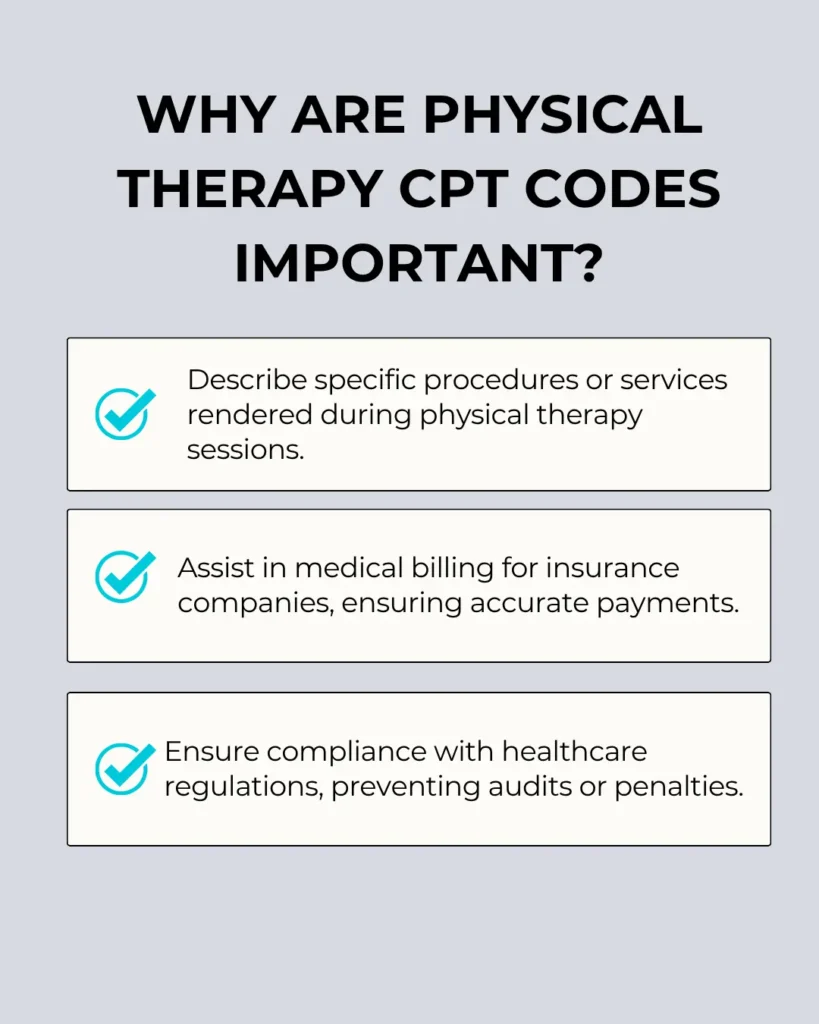As a medical practitioner, proper coding is essential for timely and accurate reimbursement. Physical therapy CPT codes (Current Procedural Terminology codes) are a crucial aspect of medical coding, especially for services rendered in physical therapy. Understanding these codes helps you avoid billing errors, ensure accurate reimbursement, and improve overall revenue cycle management (RCM).
In this guide, we’ll break down everything you need to know about physical therapy CPT codes, including their significance, how to use them correctly, and why they matter for revenue cycle management. Whether you’re a medical professional handling your billing or you work with a medical billing company, understanding these codes is key to ensuring that your practice runs smoothly and gets paid accurately for the services you provide.
What Are Physical Therapy CPT Codes?
CPT Codes Explained
Physical therapy CPT codes are a set of alphanumeric codes used to describe specific physical therapy services. These codes help ensure that the procedures performed in your practice are accurately represented in the billing process. Properly applying these codes is essential for reimbursement from insurance companies, including Medicare, Medicaid, and private insurers.

For medical practitioners, mastering these codes is crucial for maintaining the financial health of your practice.
Common Physical Therapy CPT Codes
1. Therapeutic Exercises (CPT 97110)
One of the most commonly used physical therapy CPT codes is CPT 97110, which covers therapeutic exercises. This code applies to treatments designed to improve strength, flexibility, balance, and endurance. It’s essential for any rehabilitation program.
- Example Services:
- Strength training exercises
- Range of motion exercises
- Post-surgical rehabilitation
- Strength training exercises
- Important Note: This code applies only when the therapist performs therapeutic exercises with direct patient involvement.
2. Manual Therapy Techniques (CPT 97140)
Manual therapy is a critical part of physical therapy, and CPT 97140 is used for various hands-on techniques, such as joint mobilization, soft tissue manipulation, and manual stretching. This code is essential for billing manual interventions provided by physical therapists.
- Example Services:
- Joint mobilizations
- Myofascial release
- Soft tissue mobilization
- Joint mobilizations
- Important Note: The code applies only when the therapist directly manipulates the patient’s body.
3. Neuromuscular Re-education (CPT 97112)
CPT 97112 is used to describe therapeutic interventions aimed at restoring normal neuromuscular function, such as balance and coordination. This code is commonly used in cases of neurological disorders or injuries that affect coordination and muscle control.
- Example Services:
- Balance training
- Proprioceptive training
- Postural training
- Balance training
How Physical Therapy CPT Codes Affect Medical Billing and Reimbursement
Billing and Documentation
Accurate documentation is crucial for medical billing services for small practices. Each CPT code must be supported by appropriate medical documentation, including:
- Patient diagnosis
- Treatment plan
- Details of each procedure performed
For instance, if you provide CPT 97110 for therapeutic exercises, the documentation should outline the specific exercises performed, the duration, and the frequency of the sessions. This helps avoid claim denials and delays in payment.
Reimbursement Rates
Insurance companies, including Medicare, use CPT codes to determine the appropriate reimbursement for physical therapy services. Reimbursement rates can vary significantly depending on the procedure, setting, and insurer. It’s important to know that:
- Some physical therapy services, like manual therapy (CPT 97140), may have a higher reimbursement rate than others.
- Some insurers may limit the number of sessions they’ll reimburse for certain procedures.
In Revenue Cycle Management (RCM), the goal is to ensure timely and accurate reimbursement for services rendered. Proper application of physical therapy CPT codes is essential in this process. Here’s how CPT codes fit into the broader RCM:
- Faster claim processing: Accurate coding reduces claim rejections and delays, speeding up the reimbursement process.
- Reduced administrative workload: Proper coding minimizes the need for follow-up and resubmissions.
- Improved cash flow: By ensuring correct reimbursement rates, CPT codes contribute to a steady revenue stream.
Working with a Medical Company
For many medical practices, partnering with a medical billing company is the best way to ensure proper CPT code usage and optimize the revenue cycle. A professional billing service helps:
- Ensure accurate coding for all physical therapy services.
- Submit clean claims quickly to avoid delays.
- Track denials and resubmit claims with proper documentation.
Best Practices for Using
- Stay Updated on CPT Code Changes: CPT codes change regularly. Be sure to stay updated on revisions and new codes to ensure accuracy.
- Use Proper Documentation: Ensure that your medical records and notes support the services billed, as insurance companies often require detailed documentation to approve claims.
Conclusion
Using the correct physical therapy CPT codes is essential for ensuring accurate billing, proper reimbursement, and compliance with insurance requirements. Whether you’re a small clinic or part of a larger practice, understanding how to apply these codes effectively can improve your practice’s revenue cycle, reduce denials, and maintain financial stability.
For practices that want to optimize their medical billing and coding process, partnering with a reliable medical billing company can be a game-changer. These experts can help ensure that your physical therapy services are properly coded, increasing the efficiency of your Revenue Cycle Management healthcare.
FAQs
Q: What are the most common physical therapy CPT codes?
A: The most common physical therapy CPT codes are CPT 97110 (Therapeutic Exercises), CPT 97140 (Manual Therapy), and CPT 97112 (Neuromuscular Re-education).
Q: Why is accurate physical therapy CPT coding important?
A: Accurate coding ensures proper reimbursement, avoids claim denials, and helps maintain compliance with insurance regulations.
Q: How does a medical billing company help with physical therapy CPT codes?
A: A medical billing company ensures correct CPT code usage, handles claim submissions, tracks denials, and ensures timely reimbursement.
Q: How often do physical therapy CPT codes change?
A: CPT codes are updated annually. Healthcare providers and billing teams need to stay informed about new codes and revisions.
Q: How can I improve my revenue cycle management for physical therapy services?
A: Implementing accurate CPT coding and partnering with a medical billing company to handle billing ensures quicker reimbursements and reduces administrative workload.







